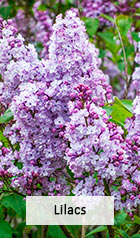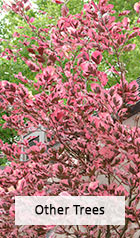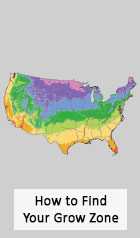- Fall Preview
- Perennials
Close X
Reliable color year after year.
- Bulbs
Close X
Fill your summer with blooms.
- Clematis & Vines
Close X
Provide ambiance and romance.
- Shrubs
Close X
Habitat, color & design possibilities.
- Trees
Close X
A gift for the next generation.
- Patio Orchard
- Fruits
- Tools & Décor
Close X
The right tools make gardening a pleasure.
- Spring Clearance
- Gardening Resources
Close X
Tips and tricks for easy, beautiful gardens.
-

-
Privacy Hedge Plants
Growing a privacy hedge can reward you again and again. Not only does it provide privacy from neighbors or street traffic, a privacy hedge can also serve as a windbreak or a sound barrier. Depending on your goals, privacy screenings can be created by growing evergreen or deciduous shrubs. Most gardeners want to grow privacy hedges in a hurry, and that's why we offer Ready, Set, Hedge!™ shrubs. Grown in the sandy, nutrient-rich soils of Holland, Michigan, these shrubs have large, healthy root systems that are quick to establish, grow fast and give your garden a more mature look.
Privacy Hedges: Getting the Most out of Your Purchase
Privacy hedges provide structure and shape to your yard. They not only provide a blocked line of sight between homes, they also provide wind block and natural snow fencing. Privacy hedges can even help lower the cost of heating in wintertime. To help your hedges flourish, there are a few things to know about their care and about choosing the right plants for your privacy hedge.
Getting Started With Privacy Hedge Plants
To plant privacy hedges, you'll need to select the right plants for your wants, needs, and climate. Consider the following elements:
- Appearance: Are you looking for flowering shrubbery, or the thickest possible hedge? Do you want a deciduous hedge for color and seasonality, or do you prefer the year-round coverage of evergreens? Some beautiful designs can be created by mixing species in a hedge, too.
- Size: Consider the mature width of your hedges, as well as the potential height. How much room do your hedges need to flourish and how many you'd like to put in a row.
- Climate needs: Most sun-loving hedges, including most evergreens, need at least six hours of sun per day. Flowering shrubs may require partial shade, or indirect sun.
- Environmental needs: Be sure to investigate what kind of soil and moisture your chosen privacy hedge plants will need. Are they tolerant of most soils or need a higher or lower pH? And how much moisture is required?
When to Plant Privacy Hedges
Like most other nursery stock, most privacy hedges perform best when planted in fall. However, some types of hedges, especially flowering types, require spring planting. Evergreens should be planted right around the time of the first frost. For best results, check your specific species of hedge for planting times.
How to Plant Privacy Hedges
Hedge planting is a fairly straightforward task, although it involves a bit of pre-planning. Before planting, select a location and mark the ground to make sure that your hedges will be spaced appropriately. Now you're ready to prepare the site and plant.
- Create a planting area about twice as wide as the container in which you received your shrub, or about a foot wide for a bareroot. Use a shovel or hoe to clear grass and debris from your planting site.
- Dig a hole about twice as wide as the container, and just as deep. Build a small mound at the bottom of the hole over which you will spread the plant's roots.
- You'll set the shrub at the same height at which it was set in the container so that its roots are firmly below ground.
- Remove the shrub from its container, loosen the soil and spread the roots gently. Set the plant into the hole, spreading its roots over the mound you created and water it in . As you backfill the hole, water in after adding each foot of soil, to remove any air pockets.
- Mulch around your plants, adding a layer one inch thick for protection against cold weather. Don't pile mulch up against the base of the shrub, as doing so can lead to pest issues.
- For the first year of your shrub's life in your landscape, water the shrubs regularly and don't allow them to dry out completely. Use a "complete" fertilizer, or one that is slightly high in nitrogen, twice per year.
How to Trim Privacy Hedges?
Evergreen hedges, and most tall privacy hedges, need to be pruned to maintain their size and shape. In addition, privacy hedges need interior trimming. Shrubs that are too thick won't allow sunlight into the interior, preventing growth along the trunk and branches. For most privacy hedges, pruning should take place in the winter, just before the weather begins to warm. For evergreens, prune earlier in the winter, while the plants are at their most dormant. Spring-flowering plants can be pruned after their flowers fade in spring. To prune, use hand-pruning trimmers or a small powered trimmer along with bigger shears. Shear the plants to their desired maintenance and shape, starting at the trunk and pruning upward and outward. You can trim a good deal off these plants, up to one third of their size, but don't flatten the top of the plant. Use trimmers to clip a branch off of the hedges every few feet. Trim those interior branches at a 45 degree angle. Be sure to make a plan for trimming before you start, to avoid lopsided hedges, and take a few steps back to eye the hedge as you trim. Privacy hedges should be wider at the bottom than the top.
What is the quickest growing hedge plant?Gardeners often plant hedges as soon as they realize the need for privacy—and don't want to wait years for their natural fencing to mature. Some of the fastest-growing hedges include dogwood, hemlock, and burning bush varieties. However, for absolute speed, arborvitae cannot be beaten. Arborvitae can grow more than three feet per year, while maintaining a gorgeous shape.
What is the best low maintenance hedge?Most privacy hedges are relatively low-maintenance. After all, they are planted to serve a specific purpose—to grow thick and large. When considering the maintenance needs of a hedge, consider both pruning and annual cleanup. Flowering hedges and deciduous plants may require a bit less pruning—think viburnum and burning bush. However, evergreens may require more aggressive pruning if you want to maintain their shape.
What is the cheapest privacy hedge?For a cheap, fast-growing hedge, you can't go wrong with a 'Green Giant' arborvitae, or any other arborvitae. These plants take off, growth-wise, and they're extremely hardy. Evergreen arborvitae provide year-round privacy and wind protection, too.
How long does a hedge take to grow?Hedge growth rates depend upon species. Arborvitae and other evergreen hedges can grow at a rate of over three feet each year. Flowering and dwarf varieties will grow more slowly.

































